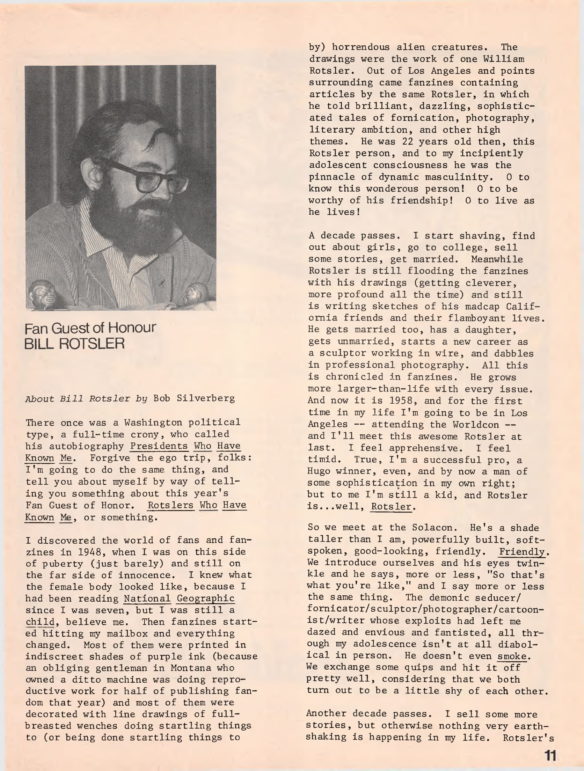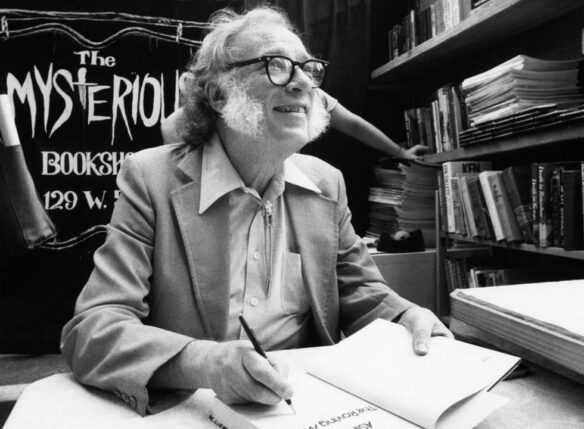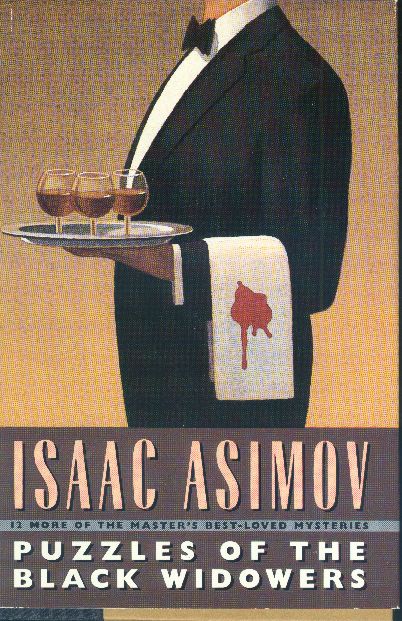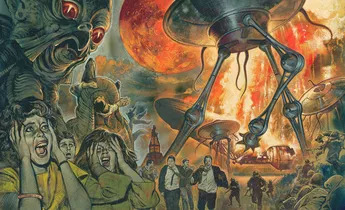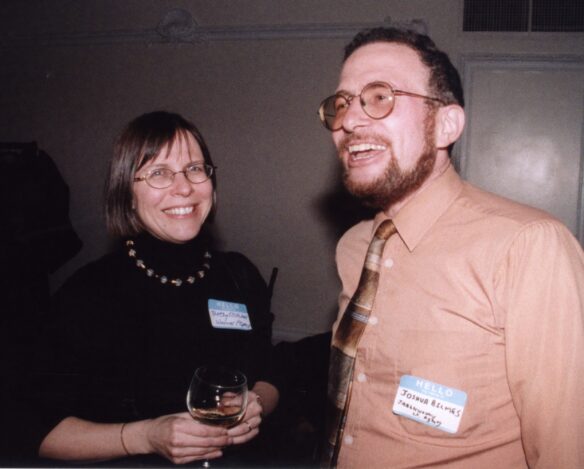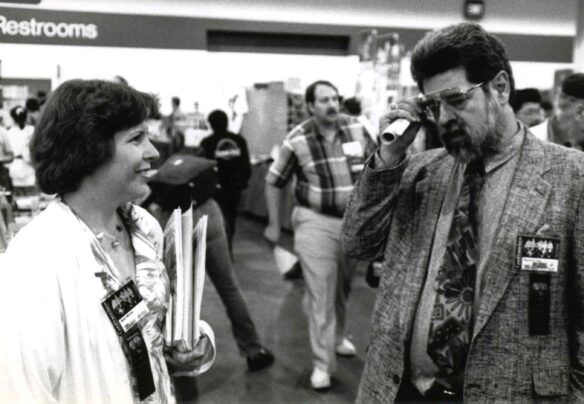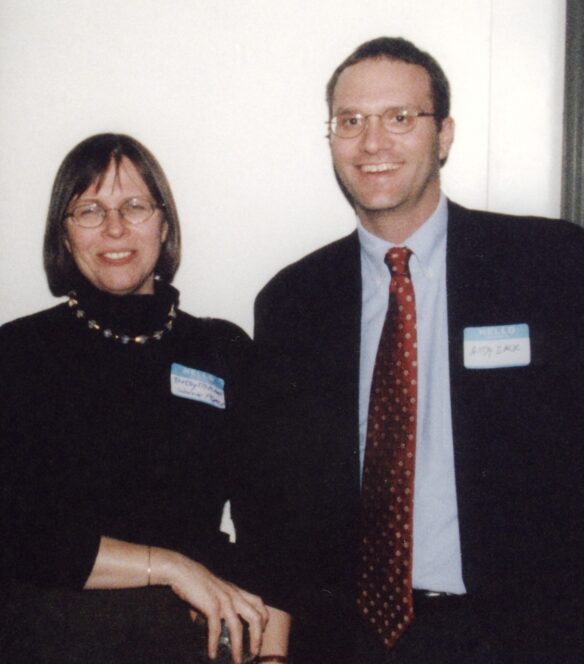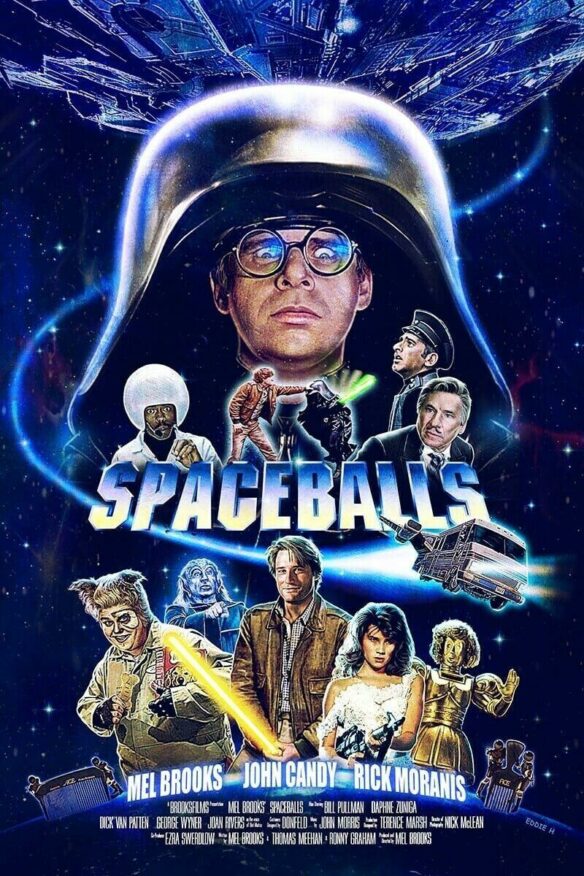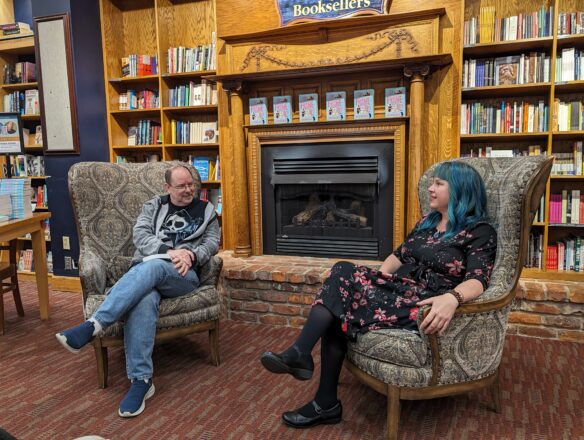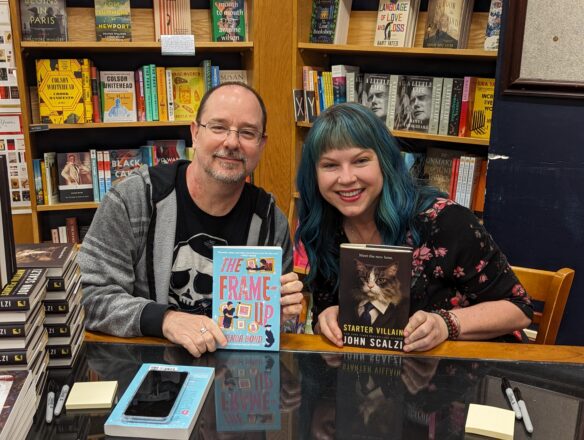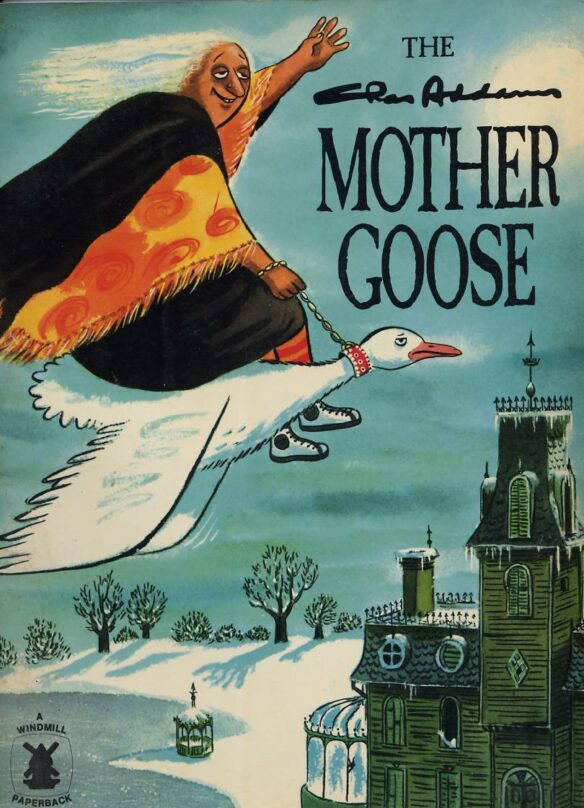(1) WILE E.’S DAY. We’ll get to see it after all: “Warner Bros Completes Sale Of ‘Coyote Vs. Acme’ To Ketchup” reports Deadline.
Ketchup Entertainment today confirmed their completed deal for worldwide rights to the live-action/animated hybrid film that brings Looney Tunes character Wile E. Coyote to the big screen. We had the deal pegged in the $50M range and the film is expected to get a theatrical release in 2026….
….The film is based on the Looney Tunes characters and the New Yorker humor article “Coyote v. Acme” by Ian Frazier.
Will Forte, John Cena, Lana Condor and Tone Bell star in the movie, which follows Wile E. Coyote, who, after Acme products fail him one too many times in his dogged pursuit of the Roadrunner, decides to hire a billboard lawyer to sue the Acme Corporation. The case pits Wile E. and his lawyer (Forte) against the latter’s intimidating former boss (Cena), but a growing friendship between man and cartoon stokes their determination to win….
(2) #30#. NaNoWriMo (National Novel Writing Month) has announced that the organization is shutting down. They offer a lengthy explanation in “The State of NaNoWriMo – A Community Update – March 2025” on YouTube.
We come to you today with a major operational update and important news about the future of the organization and we encourage you to listen to it in its entirety. This video shares real data and information that the organization has not discussed previously. It also contains some important acknowledgments and information about the logistics of our next steps.
This is the aftermath of a controversy that erupted last September when they issued an equivocal statement about using AI – when it did not go unnoticed that NaNoWriMo is sponsored by ProWritingAid, a writing app that advertises AI-powered technology, including text rewrites – and Writers Board members Daniel Jose Older, Cass Morris, and Rebecca Kim Wells immediately resigned.
(3) KICKSTARTER FOR LONG LIST ANTHOLOGY 9. [Item by Ziv Wities.] The Long List Anthology series collects stories that show up on the Hugo Award finalist tally, based on the official report of the top fifteen finishers in each Hugo category.
Long List Anthology Volume 9 is drawn from the Long List of the 2024 Hugo Awards. This volume is co-edited by David Steffen, Chelle Parker, and Hal Y. Zhang, with original cover art by Evelyne Park. The new volume includes stories by genre favorites, new voices, and three translations of stories originally published in Chinese — including one translation which is original to the LLA.
Join the Kickstarter here: “The Long List Anthology Volume 9 by David Steffen”.

(4) SOCIETY OF ILLUSTRATORS 2025 HOF INDUCTEES. The Society of Illustrators have announced the 2025 Hall of Fame recipients, contemporary artists Rudy Gutierrez, Kadir Nelson, and Tim O’Brien, and posthumous honorees Peter Arno, Frank R. Paul, and Marie Severin. The Society’s Hall of Fame Induction Ceremony will be held on Thursday, October 9.
Here is what the press release says about artists of genre interest Paul and Severin.

Frank R. Paul (1884 – 1963) was a pioneering American illustrator best known for shaping the visual language of science fiction during the early 20th century. His bold, visionary artwork graced the covers of seminal pulp magazines such as Amazing Stories, Science Wonder Stories, and Fantastic Adventures, introducing readers to a vibrant, imaginative future filled with spaceships, robots, and alien worlds. Trained in mechanical drafting and architecture, Paul brought an unmatched level of technical precision and grandeur to his work, helping to define the aesthetic of speculative fiction long before the rise of popular sci-fi cinema. In an era before comic books or concept art departments, Paul created entire worlds from scratch, often illustrating full-color covers, interior black-and-white pieces, and even full spreads for each issue. Over the course of his career, he illustrated thousands of works and played a foundational role in inspiring generations of artists, writers, and filmmakers. He is widely regarded as the first major science fiction artist, and his influence is still seen in visual media today. Frank R. Paul was inducted into the Science Fiction Hall of Fame in 2009 for his trailblazing contributions to the genre.

Marie Severin (1929 – 2018) was a legendary comic book artist and colorist whose work helped define the visual identity of both EC Comics and Marvel Comics throughout the mid-20th century. Beginning her career as a colorist at EC in the 1950s, she quickly earned recognition for her keen sense of composition, storytelling, and humor, eventually moving into penciling and inking as one of the few prominent female artists in the male-dominated industry of the Silver Age. At Marvel, she co-created iconic characters such as the Living Tribunal and worked on titles including Doctor Strange, The Hulk, Sub-Mariner, Iron Man, and Not Brand Echh, a satirical series that showcased her sharp comedic sensibility. Known affectionately as “Mirthful Marie” among peers, Severin brought a distinctive style that blended expressive characters with dynamic layouts, all while mastering the art of visual pacing. She had a unique ability to inject personality and emotion into every panel, making even the most fantastical scenarios feel grounded and human. Her behind-the-scenes influence also extended to production and design, contributing to Marvel’s overall visual tone during a crucial period of expansion and experimentation.
Her versatility as both a humorist and dramatic artist made her an invaluable creative force in every genre she touched—whether superheroes, horror, fantasy, or comedy. Severin was admired not only for her technical skill but also for her warmth, wit, and generosity within the comics community. In 2001, she was inducted into the Will Eisner Hall of Fame, and her legacy continues to inspire comic artists around the world. Marie Severin remains one of the most important and beloved figures in the history of American comics.
(5) BLACK MIRROR S7 EPISODE BRIEFING. “’Black Mirror’ Season 7 Trailer and Episode Details Revealed” by The Hollywood Reporter.
Such details include cast, synopsis, run time and credits for each standalone saga, which includes the first-ever Black Mirror sequel, for USS Callister, and a callback episode to Netflix’s first-ever interactive feature with Black Mirror: Bandersnatch.
(6) JAMESON QUINN DIES. Jameson Quinn was killed when he fell off a cliff in Guatemala on March 23. His death was announced by his mother on Bluesky. According to his son it happened when Quinn was trying to rescue a dog.

Quinn is best known to science fiction fans for helping to reform the Hugo Award nominating system in the wake of the Sad/Rabid Puppies block voting episodes of 2013-2017. He designed the EPH (E Pluribus Hugo) voting method, and helped get it adopted by the World Science Fiction Society for use in nominations for the Hugo awards. He was an active participant on Making Light, and contributed articles to File 770 and also led comment discussions about the initiative here.
Quinn’s other noteworthy accomplishments in voting theory and/or voting reform included co-organizing and attending the British Colombia Symposium on Proportional Representation in 2018 (sponsored by the Center for Election Science), and popularizing the term “Voter Satisfaction Efficiency” (VSE).
A Harvard grad school blog profile about Jameson featured his contribution to EPH as an example of his work: “A Better Way to Vote”.


(7) MEMORY LANE.
[Written by Cat Eldridge.]
Isaac Asimov’s Foundation novel
It’s the seventy-fourth anniversary of the first publication of Isaac Asimov’s Foundation as a novel. So let’s tell the history of the novel.
In the summer of 1941, Isaac Asimov proposed to John W. Campbell of Astounding Science Fiction that he write a short story set in a slowly declining Galactic Empire, based on the fall of the Roman Empire. Campbell thought the idea was great.
Then Asimov proposed writing a series of stories depicting the fall of the first Galactic Empire and the rise of the second. Asimov would write eight stories for Campbell’s magazine over eight years (1942-1949), and they were later collected into three volumes known as The Foundation Trilogy which were published from 1951 to 1953.
Foundation was first published as a single book by Gnome Press. It has “The Psychohistorians”, “The Encyclopedists” “The Mayors”, “The Traders” and “The Merchant Princes”. “The Encyclopedists” and “The Mayors” were novelettes, the others are short stories. As noted before, each was in Astounding Science Fiction.
The cover art is by David Kyle. Please note that on the cover it is titled Foundation: An Interplanetary Novel. When Ace published it they renamed it The 1,000 Year Plan in their two editions of 1955 and 1962.
At Tricon (1966), it would win the Hugo for Best All-Time Series. Other nominees were Burroughs’ Barsoom series, Heinlein’s Future History series , E. E. Smith’s Lensmen series and Tolkien’s The Lord of the Rings.
As you know, it is now streaming as a series as Apple+.
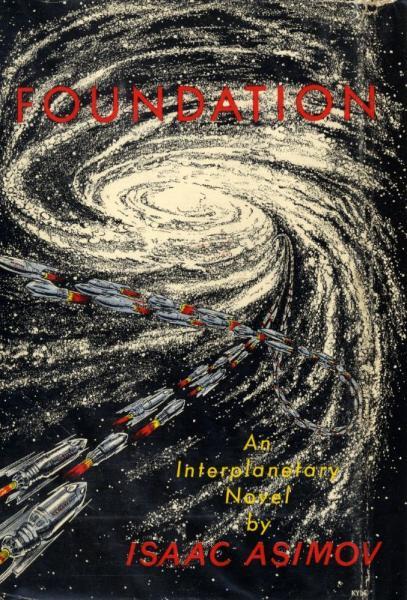
(8) COMICS SECTION.
- Saturday Morning Breakfast Cereal expects too much from the past.
- Bizarro features love language.
- Brewster Rockit delivers a short history of computers.
- Dinosaur Comics is in rapture about the value of what’s new.
- Reality Check plays mind games.
(9) THE INSIDE STORY. “Rare Merlin and King Arthur text found hidden in binding of medieval book” – Popular Science tells how it was done.
Variations on the classic Merlin and King Arthur legends span hundreds, if not thousands, of retellings. Many are documented within handwritten medieval manuscripts dating back over a millenia—but some editions are far rarer than others. For example, less than 40 copies are known to exist of a once-popular sequel series, the Suite Vulgate du Merlin. In 2019, researchers at the University of Cambridge discovered fragments of one more copy in their collections, tucked inside the recycled binding of a wealthy family’s property record from the 16th century. But at the time of discovery, the text was impossible to read.
Now after years of painstaking collaborative work with the university’s Cultural Heritage Imaging Laboratory (CHIL), archivists have finally been able to peer inside the obscured texts—without ever needing to physically handle the long-lost pages.
Experts combined multiple conservation tools and techniques to construct a 3D model of the fragments. These included multispectral imaging (MSI), which creates high-resolution images by scanning an artifact with wavelengths ranging from ultraviolet to infrared light. After borrowing X-ray and CT machines from Cambridge’s zoology department, the team then examined the parchment layers to map unseen binding structures without the need to deconstruct the delicate material. CT scanning allowed researchers to examine how the pages were stitched together using thin strips of similar parchment.
Some of the Merlin texts were unreadable due to being hidden under folds or stitching, so the team also needed to amass hundreds of images from every angle using an array of magnets, prisms, mirrors, and other tools. The combined result is a high-definition, digitized 3D model of the entire relic that unfolds, allowing experts to analyze it as though reviewing the physical manuscript itself.
The results revealed not just a part of Suite Vulgate du Merlin, but insights into the time period in which it existed. Experts now believe the sections originally belonged to a shortened edition of the tale. Given small typographical errors as well as the red and blue ink used in its handwritten decorated initials, historians traced its origins to sometime between 1275–1315 CE…
(10) TIME FOR A SNACK. Invasion ’53, written by Danielle Weinberg,is making the rounds of film festivals. View the trailer at the link.
Invasion ’53, a 10-minute short film about a man-eating alien who crashes a suburban cocktail party. The movie stars Jeffrey Combs (Re-Animator, Star Trek: Deep Space Nine) and was produced with Kurt Uebersax (Elf-Man, America’s Most Wanted).
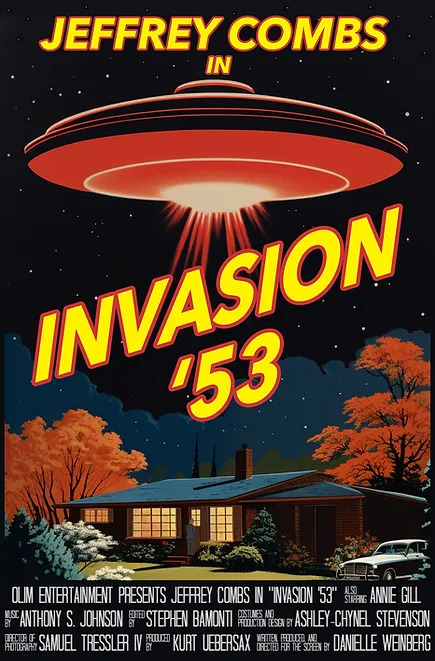
(11) FROM AN OLD FAMILIAR SCORE. “What gave life on Earth its spark? Scientists recreating a decades-old experiment offer a new clue” says CNN.
In the 1931 movie “Frankenstein,” Dr. Henry Frankenstein howling his triumph was an electrifying moment in more ways than one. As massive bolts of lightning and energy crackled, Frankenstein’s monster stirred on a laboratory table, its corpse brought to life by the power of electricity.
Electrical energy may also have sparked the beginnings of life on Earth billions of years ago, though with a bit less scenery-chewing than that classic film scene.
Earth is around 4.5 billion years old, and the oldest direct fossil evidence of ancient life — stromatolites, or microscopic organisms preserved in layers known as microbial mats — is about 3.5 billion years old. However, some scientists suspect life originated even earlier, emerging from accumulated organic molecules in primitive bodies of water, a mixture sometimes referred to as primordial soup.
But where did that organic material come from in the first place? Researchers decades ago proposed that lightning caused chemical reactions in ancient Earth’s oceans and spontaneously produced the organic molecules.
Now, new research published March 14 in the journal Science Advances suggests that fizzes of barely visible “microlightning,” generated between charged droplets of water mist, could have been potent enough to cook up amino acids from inorganic material. Amino acids — organic molecules that combine to form proteins — are life’s most basic building blocks and would have been the first step toward the evolution of life….
(12) VIDEO FROM ANCIENT DAYS. A zillion years ago, Vincent Price was on The Tonight Show with Johnny Carson to promote Theatre of Blood, in which he murders all the critics who fail to praise his Shakespearean ham acting. (How long ago was this? Sitting next to him was the singer Mama Cass Elliot, who obviously wasn’t dead yet…!)
[Thanks to Mike Kennedy, Andrew Porter, John King Tarpinian, N., Danny Sichel, Ziv Wities, Kevin Lighton, Thomas the Red, Chris Barkley, Cat Eldridge, SF Concatenation’s Jonathan Cowie, Mark Roth-Whitworth, Steven French, Kathy Sullivan, and Teddy Harvia for some of these stories. Title credit belongs to File 770 contributing editor of the day Cat Eldridge.]


